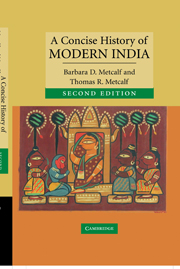Book contents
- Frontmatter
- Contents
- List of illustrations
- Preface to the second edition
- Preface to the first edition
- Glossary
- Chronology
- 1 Sultans, Mughals, and pre-colonial Indian society
- 2 Mughal twilight: the emergence of regional states and the East India Company
- 3 The East India Company Raj, 1772–1850
- 4 Revolt, the modern state, and colonized subjects, 1848–1885
- 5 Civil society, colonial constraints, 1885–1919
- 6 The crisis of the colonial order, 1919–1939
- 7 The 1940s: triumph and tragedy
- 8 Congress Raj: democracy and development, 1950–1989
- 9 Democratic India in the nineties: coalitions, class, community, consumers, and conflict
- Epilogue: a new century begins
- Biographical notes
- Bibliographic essay
- Index
- CAMBRIDGE CONCISE HISTORIES
Preface to the second edition
Published online by Cambridge University Press: 05 June 2012
- Frontmatter
- Contents
- List of illustrations
- Preface to the second edition
- Preface to the first edition
- Glossary
- Chronology
- 1 Sultans, Mughals, and pre-colonial Indian society
- 2 Mughal twilight: the emergence of regional states and the East India Company
- 3 The East India Company Raj, 1772–1850
- 4 Revolt, the modern state, and colonized subjects, 1848–1885
- 5 Civil society, colonial constraints, 1885–1919
- 6 The crisis of the colonial order, 1919–1939
- 7 The 1940s: triumph and tragedy
- 8 Congress Raj: democracy and development, 1950–1989
- 9 Democratic India in the nineties: coalitions, class, community, consumers, and conflict
- Epilogue: a new century begins
- Biographical notes
- Bibliographic essay
- Index
- CAMBRIDGE CONCISE HISTORIES
Summary
The first edition of A Concise History of India appeared in 2002, and covered events up to the end of the twentieth century in 2000. We are immensely grateful for the enthusiastic response this book has received from teachers, colleagues, and students. Though not meant as a textbook, to our pleasant surprise the Concise History has been widely adopted in university and college courses. It is our hope that this new edition will be equally well received.
One might ask why a second, revised edition is needed so soon after the first. The answer lies, in large part, in the increased pace of historical change in India, together with the rapid growth of historical scholarship on India. We endeavour in this edition to do two things: to take the story of India through the first five years of the twenty-first century, up to 2005; and, where necessary, to incorporate new perspectives, and new research into our larger narrative. We have also taken this opportunity to correct a number of factual errors and stylistic infelicities that have come to our attention.
As the wholly new ‘epilogue’ makes clear, much has happened in India since 2000. A BJP government, seemingly firmly entrenched in power when we wrote, has been displaced by a Congress-led government under Man Mohan Singh; economic growth propelled by high-technology services has propelled India to a new level of prosperity, yet one still undercut by pervasive poverty; and the country has become, as never before, a major player on the world stage, courted for the first time in fifty years by the United States.
- Type
- Chapter
- Information
- A Concise History of Modern India , pp. xiii - xivPublisher: Cambridge University PressPrint publication year: 2006

